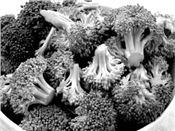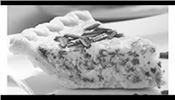Recipe Page
Broccoli- A Nutrient Dense Food

CARLA HALEY-HADLEY
TEXARKANA, ARKANSAS
Broccoli doesn’t get a lot of credit as being a favorite vegetable, but maybe it should. Those little green compact heads are bursting with nutrients, including carotenoids and fiber. Known for its anti- cancer properties, broccoli has tons of nutrients including vitamins A and C, fiber, folic acid, calcium, and potassium.
One half cup of steamed broccoli provides 80 percent of the recommended daily allowances (RDA) for vitamin C, almost 15 percent of the allowance for folate, 10percent for vitamin A, and 7 percent for iron. It is also a good source of several B vitamins, other minerals and dietary fiber. All this for only 23 calories per half cup serving!
Selecting broccoli is rather easy if you follow these guidelines.
Select heads with tight buds which range from dark green to purple in color. Avoid those that have spreading buds, are yellow in color and look wilted.
Unfortunately, broccoli is subject to insect infestation. If you select a bunch that is infested with insects, remove the insects by soaking for 30 minutes in 1 quart of cold water with 1 tablespoon of salt just before cooking. Rinse well to remove any residual salt.
Storage of broccoli is just as important as purchasing. It can be stored refrigerated in a perforated plastic bag, for 3 to 5 days. Due to the ethylene, which speeds the yellowing of broccoli, store it away from apples and pears.
There are several ways to prepare broccoli ranging from eating it raw, to boiling, grilling, stir-frying or steaming.
Before you can eat the broccoli, you must first prepare it. Peel the stems to remove the woody layer and cut it into the desired size pieces. If cooking the stem, it will need to cook slightly longer than the florets. Avoid overcooking because discoloration will occur, as well as, strong flavors are likely to develop. For best flavor, cooked broccoli should be crisp.
Quick-cooking is the best method to maintain nutrient retention.
Steam, stir-fry, or microwave for a short time until broccoli is tender but still crisp. For optimum flavor, season with a small amount of margarine or lemon juice or experiment with herbs and spices.
If you would like to receive more information on this healthy, versatile vegetable, contact me at the University of Arkansas Division of Agriculture in the Miller County Courthouse, call 870-779-3609, e- mail me at chaley@uada.edu or visit our webpage at www.uaex.uada.edu/counties/miller/
You can also find me on facebook at MillerCountyFCS or twitter #MillerCountyFCS.
Spicy Chicken and Broccoli Stir-Fry
2 cloves garlic, minced
1 tablespoon ginger
One eight teaspoon red pepper flakes
12 ounces boneless, skinless chicken breasts, cut into 2 inch pieces
1 ounce unsalted peanuts or almond slivers
2 teaspoons olive oil, divided
1 medium onion, cut into rings
1 medium carrot, thinly sliced
2 cups broccoli florets (about 1 inch pieces)
1 and one fourth cup reduced sodium chicken broth divided
1 tablespoon cornstarch
2 tablespoons low sodium soy sauce
Prepare marinade by combining garlic, ginger and red pepper flakes in small bowl. Place chicken in bowl, toss, cover & refrigerate 30 minutes, turning occasionally. Heat skillet or wok over medium-high heat until hot. Add nuts and cook 2 minutes or until beginning to lightly brown, stirring frequently. Remove from skillet and set aside.
Add 1 teaspoon oil to skillet, tilting to coat lightly. Add chicken and cook until done. Set aside on separate plate. Add remaining teaspoon oil to skillet; cook onions and carrots 2 minutes. Add broccoli and one fourth cup broth; bring to boil over medium high heat. Cover and cook 2 minutes or until broccoli is crisp-tender.
Meanwhile, combine remaining 1 cup broth with cornstarch in small jar; seal lid tightly and shake vigorously until cornstarch is completely dissolved. Add cornstarch mixture with chicken, garlic and salt to broccoli mixture. Cook 1 minute or until thickened. Remove from heat, sprinkle with soy sauce. Serve with brown rice
Makes 4 –1 & one half cup servings.
Calories, 210; Total fat 7 g; Protein 25g; Carbohydrate 12 g; Cholesterol 49 mg; Dietary Fiber 3 g; Sodium 570 mg (this does not
include the brown rice) ∆
CARLA HALEY-HADLEY: University of Arkansas
Get the Iron You Need with a Healthy Diet

This Spinach Pie Recipe Has 212 Calories Per Slice While
Offering 8% Of Your Daily Iron Needs
CARLA DUE
TEXARKANA, ARKANSAS
Sometimes you may feel like you’ve just run out of gas and can’t do anymore. Could it be that you are overworked or not getting enough quality rest? Maybe quality sleep and relaxation will help you feel energetic again, or maybe your fatigue is a symptom of iron-deficiency anemia.
Actually, anemia isn’t a disease, but rather a symptom of other health problems. Often, there is a nutritional connection.
With anemia, there aren’t enough red blood cells, or enough hemoglobin in red blood cells, to transport oxygen to body cells. When too little oxygen gets to the brain and other parts of the body, you may feel tired or irritable and have difficulty concentrating.
Some symptoms include fatigue, pale skin, weakness, headache, lack of concentration, or irritability. To produce enough red blood cells, you need enough iron in your diet, as well as enough folic acid and vitamin B12. A simple blood test at your doctor’s office can diagnose anemia. Do not self-diagnose and add an iron supplement to your diet.
Too much iron is unhealthy since our body does not excrete iron rapidly. The iron could build up over time and become toxic in some individuals.
Iron is a mineral found in every cell of the body. It is considered an essential mineral because it is needed to make hemoglobin, a part of blood cells. The human body needs iron to make the oxygen-carrying proteins hemoglobin and myoglobin. Hemoglobin is found in red blood cells and myoglobin is found in muscles.
The best food sources of iron include dried beans, dried fruits, eggs (especially egg yolks), iron-fortified cereals, liver, lean red meat (especially beef), oysters, poultry, dark red meat, salmon, tuna, and whole grains. You will get reasonable amounts of iron in your diet from lamb, pork, and shellfish.
Iron from vegetables, fruits, grains, and supplements is harder for the body to absorb. These include dried fruits such as prunes, raisins, apricots; legumes such as lima beans, soybeans, dried beans and peas, kidney beans; seeds such as almonds, brazil nuts; vegetables such as broccoli, spinach, kale, collards, asparagus, dandelion greens; and whole grain sources such as wheat, millet, oats and brown rice If you mix some lean meat, fish, or poultry with beans or dark leafy greens at a meal, you can improve absorption of vegetable sources of iron up to three times. Foods rich in vitamin C, such as citrus, strawberries, tomatoes, and potatoes, also increase iron absorption.
Cooking foods in a cast-iron skillet can also help to increase the amount of iron provided.
It is recommended by the USDA that women 19 - 50 get 18 mg of iron a day, while women 51 and older and men 19 years and beyond need 8 mg a day. Moderate amounts of meat plus fruits and vegetables can provide that amount. A balanced diet with foods fortified with iron and other vitamins and minerals, like milk, flour, and breakfast cereals will help you reach your goal.
As with all things, there can be too much of a good thing with iron consumption. Talk with your doctor before you begin to take iron supplements or a multi-vitamin with iron.
This recipe for Spinach Pie comes from the University of Missouri Extension. It has 212 calories per one eighth slice, 13 total grams fat, 219 mg sodium, 8 grams protein and 8 percent iron.
Spinach Pie
1 frozen 9-inch pie shell, thawed
4 cups spinach
2 teaspoons olive oil
1 cup Swiss cheese, grated
4 eggs, beaten
1 1/2 cups milk
1 tablespoon flour
1/8 teaspoon nutmeg
Preheat oven to 400 degrees F. Bake empty pie shell for 10 minutes.
Sauté spinach in olive oil and spread cooked spinach on bottom of baked pie shell. Sprinkle cheese over spinach. Combine eggs, milk and flour and pour over cheese. Sprinkle with nutmeg. Bake at 375 degrees F for 35 to 40 minutes or until a knife inserted into center comes out clean. ∆
CARLA DUE: University of Arkansas